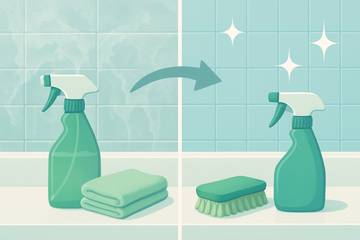How to Remove Soap Scum Naturally (And Keep It From Coming Back)
Transparency note: Educational guidance with reputable sources. Always spot-test and follow manufacturer care for your surfaces.
It’s the ghost of showers past — that stubborn, chalky film on glass doors, tile walls, and the tub. An aisle of “tub & tile” cleaners promises miracles, but you don’t need harsh chemicals to win this battle. A little chemistry does the heavy lifting.
What IS Soap Scum, Anyway?
Soap scum forms when fatty acid salts in bar soap (the “soap” part) react with hard-water minerals like calcium and magnesium to create insoluble deposits that cling to surfaces. Body soils can add to the buildup. Because these deposits aren’t water-soluble, simple rinsing won’t remove them (American Cleaning Institute; USGS).
The Ultimate Non-Toxic Soap Scum Solution
This two-ingredient spray pairs an acid (hot vinegar) to dissolve mineral bonds with a gentle surfactant (dish soap) to lift the fatty residues.
What You’ll Need
- Heavy-duty spray bottle
- Distilled white vinegar
- Gentle, non-toxic liquid dish soap
- Non-scratch scrubbing sponge or brush
Step-by-Step Instructions
- Heat the vinegar: Warm ~1 cup in a microwave-safe container (30–45s). Hot vinegar works faster (MSU Extension).
- Mix the solution: Pour hot vinegar into your spray bottle. Add an equal amount of dish soap (1:1). Swirl gently to combine.
- Spray and wait: Saturate glass, tile, and fixtures. Let sit 30–60 minutes. Turn on the fan for ventilation.
- Scrub and rinse: Scrub with a non-scratch sponge, then rinse thoroughly with warm water.
Safety: Never mix vinegar (an acid) with bleach or cleaners containing chlorine or ammonia — dangerous gases can form (American Lung Association).
Prevention: How to Keep Soap Scum From Coming Back
- Switch your soap: Body washes or glycerin-based soaps leave fewer insoluble residues than many traditional bar soaps.
- Squeegee after showers: 30 seconds removes mineral water and residues before they dry (MSU Extension).
- Use a daily spray: A light, pH-neutral maintenance spray helps prevent deposits from re-forming.
The Green Llama Way: Your Maintenance Partner
Our All-Purpose Cleaner is pH-neutral — perfect as a daily maintenance mist after your squeegee. It helps keep glass and tile clear without harsh chemicals or residue. For heavy, established scum, use the vinegar method above first, then maintain with Green Llama.
Shop the All-Purpose Starter Kit
FAQs
Can I use this vinegar + soap method on a fiberglass tub?
Yes — it’s generally safe for fiberglass, acrylic, glass, and ceramic tile. Do not use on natural stone (marble/travertine); acids can etch stone.
Why not just use a magic eraser?
Melamine foam is a micro-abrasive that can dull glossy coatings over time. The vinegar approach dissolves the scum chemically, minimizing abrasion.
The vinegar smell is strong. Will it linger?
No — it dissipates after a thorough rinse and a few minutes of ventilation.
References
- American Cleaning Institute — Chemistry of soaps, detergents & hard water (soap scum).
- USGS — Hardness of water (calcium & magnesium background).
- Michigan State University Extension — Cleaning with vinegar: what you can and cannot clean.
- American Lung Association — Cleaning supplies and your health (never mix bleach with other cleaners).





